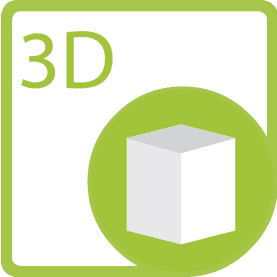.NET API for operations and conversion of 3D files
 APIs for games and CAD to read, write, process and convert 3D files, such formats as: Autodesk, 3D System CAD, Wavefront, Discrete 3D Studio 3DS, Universal 3D, Collada, glTF, GLB, PLY, DirectX and Google Draco from any applications on .NET
APIs for games and CAD to read, write, process and convert 3D files, such formats as: Autodesk, 3D System CAD, Wavefront, Discrete 3D Studio 3DS, Universal 3D, Collada, glTF, GLB, PLY, DirectX and Google Draco from any applications on .NET
Aspose.3D for .NET is a rich game development and Computer-Aided-Designing (CAD) API that provides Mono and .NET applications, including ASP.NET, Windows Forms, and Web services, with the ability to automatically interact with widely used 3D file formats without the need for any other 3D modeling and rendering software. It supports Discreet3DS, WavefrontOBJ, FBX (ASCII, Binary), STL (ASCII, Binary), Universal3D, Collada, glTF, GLB, PLY, DirectX, and Google Draco file formats, allowing developers to easily create, read, transform, process, and manipulate entities from the above 3D files using the Aspose.3D API.
The easy-to-use Aspose.3D for .NET API can be deployed with any .NET application with the same ease that files are copied without regard to other services and modules, whether they are installed or not.
Provides an overview of Aspose.3D for .NET features.
| Object Model | Main | |
|
|
|
Aspose.3D for .NET supports reading and writing of Universal3D, Discreet3DS, WavefrontOBJ, FBX7200ASCII, FBX7300ASCII, FBX7400ASCII, FBX7500ASCII, FBX7200Binary, FBX7300Binary, FBX7400Binary, FBX7500Binary, STLBinary, STLASCII, Collada, glTF, GLB, PLY, DirectX and Google Draco.
| ⇑⇓ Input/Output | Input only ⇓ | |
|
|
|
| Output only ⇑ | ||
|
Aspose.3D for .NET supports the .NET framework.
| Mono | Framework .NET | |
| Mono ⇒ |
|
⇐ ASP.NET Web Applications ⇐ Web services ⇐ Windows Applications |
Convert 3D files to and from a variety of 3D formats
- Convert FBX to STL, WavefrontOBJ, Discreet3DS, and Universal3D
- Convert Discreet3DS to FBX, STL, WavefrontOBJ, and Universal3D
- Convert STL to FBX, WavefrontOBJ, Discreet3DS, and Universal3D
- Convert Universal3D to FBX, STL, WavefrontOBJ, and Discreet3DS
- Convert WavefrontOBJ to FBX, STL, Discreet3DS, and Universal3D
Advanced API capabilities
| Create 3D scenes and save them in supported 3D file formats | Load, save, and convert 3D documents to a stream | Working with geometry and scene hierarchy |
| Distribute grid geometry data between many nodes | Adding animation properties to scenes in 3D documents | Surface mesh triangulation using a custom vertex structure |
| Add a target camera to a 3D scene | Animate objects in a 3D scene | Separation of grids by materials |
| Render 3D views to a graphic format | Translation and retrieval of shadows from 3D geometries |
Generate blank documents with 3D scenes and save as 3D files
Aspose.3D for .NET provides programmers with easy ability to generate 3D scene documents from scratch using the 3D API for .NET and save them to supported 3D file formats (FBX, STL, WavefrontOBJ, Discreet3DS, Universal3D, and Collada) by calling the Open and Save methods from an object of the Scene class.
Add metadata information to a 3D scene
Metadata is structured information that describes, localizes, and makes it easier to retrieve, use, and manage information about resources. The Aspose.3D for .NET API enables developers to define metadata for a scene.
Create a mesh of a 3-dimensional cube
A mesh is composed of a set of control points in space and polygons that describe the surface of the mesh. Aspose.3D for .NET API allows developers to define sets of checkpoints and sets of N-dimensional polygons, if necessary.
Setting the normal or UV on a cube
The Aspose.3D for .NET API offers normal (geometry) and UV control on geometric shapes. The mesh stores the key properties for each vertex in its position in space and in its normal vector perpendicular to the original surface. Normal is the basis for counting halftones. The normal must be in normed in unit vectors. Most grid formats also support some form of UV coordinates, which are a separate 2-dimensional representation of a “expanded” grid, showing which part of a 2-dimensional texture map is applied to different grid polygons.
Add a hierarchy of nodes in a document with 3-dimensional scenes
The Aspose.3D for .NET API suggests building a hierarchy of Nodes. Node is the basic building block of a scene. The node hierarchy defines the logical structure of the scene and provides visible content through attached geometries, highlighting, and cameras to the nodes.
Distribute grid geometry data between many nodes
To reduce memory requirements, a mesh entity can be combined with various entities of the Node class. Imagine that you are working with a system in which there are a large number of indistinguishable 3-dimensional cubes. In this case, you could create one Mesh object at system startup and then, each time you need another shape, you create a new Node object, then point that object to an existing Mesh object. In this way, the Aspose.3D for .NET API manages object instances.
Triangulation of the grid with vertex data in the user-defined memory structure
Converts a grid into a set of triangles because any complex structure can be represented as a set of triangles. Graphics and hardware software operate graphics more efficiently if they are represented in the form of triangles. Information about the distribution of vertices in memory is also important in order to load the GPU, since the GPU must also have information about the location of the vertices in order to extract the corresponding attributes from the buffer.
Does not depend on any externally installed software
To work with 3D files, the Aspose API.3D built using managed code that is independent of any external API or software. It is a perfectly adapted solution in terms of supported capabilities, security, stability, scalability, speed and cost.